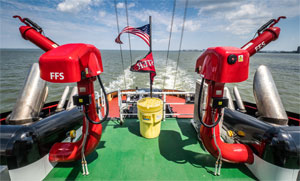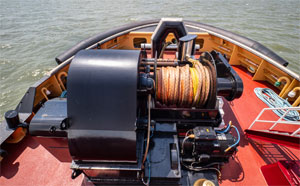McAllister Towing and Transportation Co. operates more than 50 tugboats across a dozen East Coast ports. There aren’t many like Rosemary McAllister in the company fleet — or anywhere else for that matter.
Eastern Shipbuilding delivered the 100-by-40-foot ship-docking, escort and firefighting tugboat in summer 2018 based on a design from Jensen Maritime Consultants. The 6,772-hp vessel has Caterpillar Tier 4 engines, Schottel z-drives and delivers 80 metric tons of bollard pull.
Eastern, based in Panama City, Fla., was on track to deliver sister tug Ava M. McAllister in June 2019, with Capt. Jim McAllister to follow a few months later. Those two share the same hull and propulsion package as lead tug Capt. Brian A. McAllister and its twin Rosemary McAllister, but have different winches and firefighting capabilities.
“It’s going to be the new standard for large tugs for the next few decades,” Capt. J. Elliott Westall, general manager and vice president of McAllister’s Norfolk office, said of Rosemary. “These 7,000-hp boats have the necessary power these post-Panamax ships will need to add an extra margin of safety to docking or sailing.”
 |
|
Capt. Larry Sullivan and deck hand Michael Gray deploy the Jason’s cradle man-overboard rescue device. |
Capt. Christopher Hoffmann, a McAllister tug captain in Norfolk, offered distinct praise for the vessel. “She is versatile, she is beamy and she is stable,” he said last summer while transiting to a job in Newport News, Va. “It’s a McAllister tug on steroids.”
McAllister Towing originally awarded the contract for this tugboat series to Horizon Shipbuilding in Bayou La Batre, Ala., which declared bankruptcy not long after delivering Capt. Brian A. McAllister in 2017. Eastern stepped in to finish the next two hulls already under construction in addition to starting work on Capt. Jim, the last tugboat in the four-vessel series.
Eastern encountered challenges of its own following a direct hit from Hurricane Michael last fall. The storm upended construction at the yard for weeks as employees worked to rebuild their lives. Marty Costa, McAllister’s engineering manager, said the shipyard responded extremely well to unprecedented challenges.
“The storm didn’t really slow us down. They might have lost three weeks, if that. We had the house on Ava and all the equipment in, and Capt. Jim had just been rolled and set up a day before,” Costa said. “That one I was a little nervous about. Is she going to stay upright? But there were no issues and really no damage.”
 |
|
FFS fire monitors aboard Rosemary McAllister can each disperse more than 5,000 gpm. |
One serious challenge after the storm, he said, was widespread debris and infrastructure damage that prevented workers from reaching the shipyard. Eastern set up temporary housing and offered zero-interest loans to help affected crews. By Nov. 1, three weeks after the hurricane, the shipyard reported more than 80 percent of its workforce was back on the job.
Nearly everything about Capt. Brian and Rosemary was chosen for maximum versatility. Capt. Brian is based in New York, where it escorts and assists some of the largest ships calling the Eastern Seaboard. Rosemary works many of the same ultra-large container vessels (ULCV) that also call Norfolk’s container terminals.
Markey supplied the 100-hp hawser winches on both tugs. These units boast 350,000 pounds of line pull, 253 tons of brake holding force and the patented render/recover system that maintains constant line tension. The electric Markey stern winch on the two lead vessels can hold 2,500 feet of 2.5-inch towing wire to handle myriad offshore rescue towing jobs. The tugs’ nearly 60,000-gallon fuel tanks let them travel long distances from port.
The two lead tugs have advanced firefighting systems that earned them an FFV1 rating. Two remotely controlled FFS fire monitors are each rated for 5,284 gallons per minute. Twin Caterpillar diesel engines power dual FFS fire pumps each rated for 5,980 gallons per minute. A deluge system protects the hull from heat and flames during firefighting ops.
 |
|
Like lead boat Capt. Brian A. McAllister, Rosemary McAllister has a 100-hp Markey winch on the bow. Sister tugs Ava and Capt. Jim, the third and fourth boats in the series, have 75-hp Markey hawsers. |
The only real differences between the two lead boats and Ava and Capt. Jim are in the winches and firefighting. Both are scaled down somewhat without sacrificing ship-docking and escort capabilities, Costa said. Both have 75-hp Markey winches on the bow and single-drum towing winches aft. The firefighting systems aboard Ava and Capt. Jim consist of two 1,500-gpm manually operated fire monitors fed by a 3,000-gpm FFS pump powered by a Cat C9.3 engine. These two vessels did not receive the same FFV1 rating as their earlier siblings.
“The rationale for building the other two the way we did is they are available for LNG (liquefied natural gas) escorts if we ever needed them for that,” Costa said, referring to Capt. Brian and Rosemary.
“They are all going to do ship docking, they are all going to do tethered escorts,” he said of the four boats in the series. “The smaller winches just don’t have the same offshore capability.”
It varies based on how you measure it, but the Port of Virginia is one of the top five busiest ports on the East Coast. For the 10 months between July 2018 and April 2019, the container terminals moved almost 2.5 million TEU, a 3 percent increase over the same period a year earlier. Total ship calls were down by 111 overall during that 10-month period to 1,320 overall. The growing presence of ULCVs that can hold up to 14,000 TEU is a key reason for declining ship calls.
 |
 |
|
|
Propulsion across the four-tug series comes from Schottel z-drives. At right, chief engineer John Pannell stands alongside a Cat 3516E Tier 4 engine. |
||
“If you have a deep port, you’re going to get the behemoths, and the Rosemary can handle anything we get in here,” Westall said.
Although the tug is plenty powerful, the hull form itself is a key ally during tethered assists on massive ships loaded down with cargo. Rather than relying on an overly aggressive skeg, the Jensen-designed hull takes advantage of the hull shape and 40-foot beam for improved escort capabilities compared to McAllister’s earlier 96-foot-long, Jensen-designed tugs.
The propulsion package across the four boats is unchanged. Twin Cat 3516E engines generating 3,386 hp at 1,800 rpm turn Schottel z-drives with 110-inch props. Ship service power comes from three Cat C7.1 engines driving 118-kW generators.
The engine room has a 2,500-gallon tank for diesel exhaust fluid (DEF) injected into the exhaust system to meet Tier 4 emissions rules. The tank is stainless steel and located within a climate-controlled part of the engine room to prevent the chemical from breaking down. The urea compound is susceptible to degradation at higher temperatures. Other parts of the engine room also are climate controlled.
 |
|
Jensen’s 100-foot tug design features a spacious engine room with high ceilings and plenty of room to move around. |
“Crew comfort is definitely a big one,” said John Pannell, engineer aboard Rosemary McAllister. “And having an engine control room is not common on a tugboat. The majority of the vital electronics are in a climate-controlled engine control room.”
The docking pilots working in Hampton Roads have found plenty to like about Rosemary. Capt. Tyler Moore, with Independent Docking Pilots, said the new McAllister tugs were built with the future in mind. The vessels, he said, are “incredible packages that maximize our ability to control these behemoths while also minimizing our impact on the environment.”
The interior layout is virtually unchanged between Capt. Brian at the start of the build project and Capt. Jim at the end. The tugs typically run with four- or five-person crews, who spend their off time in four cabins. Three are doubles, with a single for the captain. The mess is separate from the large lounge/galley that makes ample use of the 40-foot beam.
The three gensets were placed aft of the engines in the z-drive compartment to reduce noise and vibration in crew spaces, particularly the two lower-level cabins. Thick mineral wool insulation wrapping the engine room reduces heat and vibration emanating from the space.
 |
|
Capt. Larry Sullivan helming Rosemary McAllister off Hampton Roads last summer. |
Capt. Brian A. McAllister is named for the current chairman of the New York City-based tugboat company. He is the husband of Rosemary McAllister. Ava McAllister (pronounced “Ahh-va”) is the daughter of Andrew McAllister, a vice president and a fifth-generation family member. Capt. Jim honors the late Capt. James McAllister, a second-generation leader of the company responsible for much of its early expansion.
McAllister has not decided which ports Ava and Capt. Jim will work, although it’s safe to assume they’ll be assigned to a deepwater port with regular visits from ULCVs.
With nearly a year in service, the captains, crews and pilots have found much to appreciate about the new tug class. “Everything on this boat is very well done,” said Rosemary Capt. Larry Sullivan. “And this is some well-needed horsepower in Virginia.”

